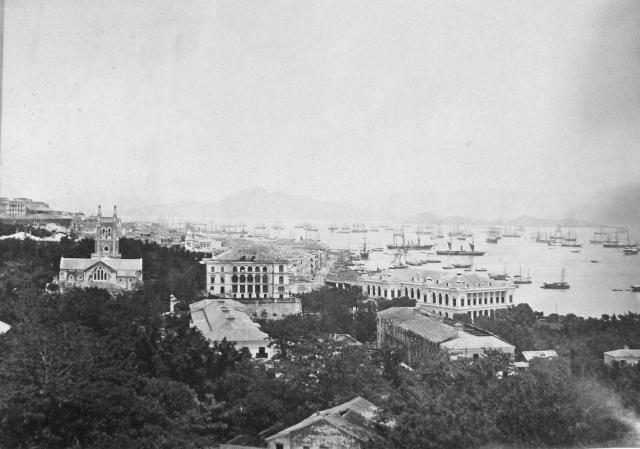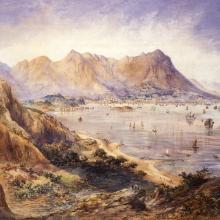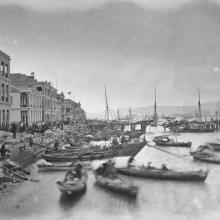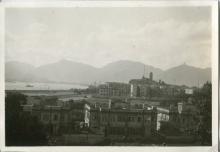View from Headquarters
Primary tabs

Submitted by Admin
Date picture taken (may be approximate):
Saturday, January 1, 1870
Gallery:
Connections:
- View from Headquarters shows Place St John's Cathedral [1849- ]
- View from Headquarters shows Place Pedder Street Clock Tower [1862-1913]
- View from Headquarters shows Place Murray Barracks [c.1846-1962]
- View from Headquarters shows Place Former French Mission Building, 1 Battery Path [1919- ]
- View from Headquarters shows Place Wardley House/HSBC Headquarters Building (1st Generation) [1857-1882]
- View from Headquarters shows Place City Hall (first generation) [1869-1936]
- View from Headquarters shows Place Johnston's House / Heard & Co / Beaconsfield [1843-1916]




Comments
View from Headquarters
The caption for this pic, "View from Headquarters", is not on the image itself, so I'm not sure where it comes from. Perhaps it was written on the back? Anyway, from the alignment of the buildings and reference to the 1880 map of "The Military Cantonment, Victoria" at Page 164 of Mapping HK, it's obvious that the photo was taken from near the "Head Quarter House", later renamed Flagstaff House and now occupied by the Tea Ware Museum ( http://gwulo.com/node/5755 ).
Information on Gwulo helps to narrow the period in which the photo was taken to between sometime in the 1870's ( when the third storey was added to the French Mission Building, see www.gwulo.com/atom/14039 ) and 1882 ( the year of demolition of HSBC HQ Generation I, see www.gwulo.com/node/6721 ).
Further clues may come from the two long buildings standing parallel to each other in the lower middle of the picture. These are Barrack Blocks B (right) and C (left) of Murray Barracks (bottom map, Page 160-1, Mapping HK). Under magnification, Block B looks to be in the midst of reroofing whilst Block C's roof is intact. Much of Block B's roof on its north side is open to the elements, but a cover has been erected over its south side. Back then strong typhoons often caused serious damage to buildings, including blowing roofs off, so I wonder if that is what had happened to Block B? The smaller building in the foreground of the photo also has a hole in its roof, supporting the possibility that a typhoon had recently struck.
Time Out ( http://www.timeout.com.hk/around-town/features/60599/hong-kongs-top-10-t... ) listed HK's ten strongest typhoons, only one of which struck during the period the photo was taken, from 1870 to 1882. It hit on the 22nd and 23rd September 1874. The HK Daily Press covered the disaster in its 24th September edition, reported widespread damage and specifically mentioned, "The principle portion of the roof was blown off one block of the Murray Barracks", although St. John's Cathedral and the buildings on Queen's Road escaped serious damage. As far as can be seen these three statements are consistent with the old photo.
One aspect in which the picture may not corroborate the newspaper coverage is in respect of City Hall. Whereas the media report mentioned the north east corner of the building had been badly damaged, I can't see anything suggesting this in the photo. However, if the damage was confined to the north face of the building, it would be out of camera shot.
If the reroofing of Barrack Block B seen in the old photo was the result of the September 1874 typhoon, and assuming it would take a few months to make significant progress on repairs, the photo can be dated to late 1874 or early 1875.
re: View from headquarters
Thanks for the extra research. I've set the date to early 1875 as suggested.
A paper label on the page in the album has this note:
No. 442. - View of Hongkong from Head Quarters
At the back or left of Picture is Victoria Peak and Albang (sic.), the large building in the midst of the trees is the Governor's residence, and nearer the harbour is St. John's Cathedral and the old Russian Consulate, facing the harbour and close to the water's edge is the City Hall, the land in the distance just rising above the water is known as Stone cutter's island.
So the photo above is only one section. The album copy had another section to the left, showing the Peak and the Albany.
Regards, David
Re ; View from Headquarters
Oops, better correct myself before someone else does!
The photo shows St. John's Cathedral before the east chancery was added. According to Page 64 of "Imperial to International: A History of St. John's Cathedral Hong Kong" by Stuart Wolfendale, work on the east chancery "was completed towards the end of 1872". If so, the photo must have been taken before then.
City Hall is also seen in the photo. It was completed in 1869 ( www.gwulo.com/node/6721 ) so the photo was taken from 1869 onwards.
That narrows the date range to sometime between 1869 and 1872.
I've pushed the date back to
I've pushed the date back to 1870.
Regards, David